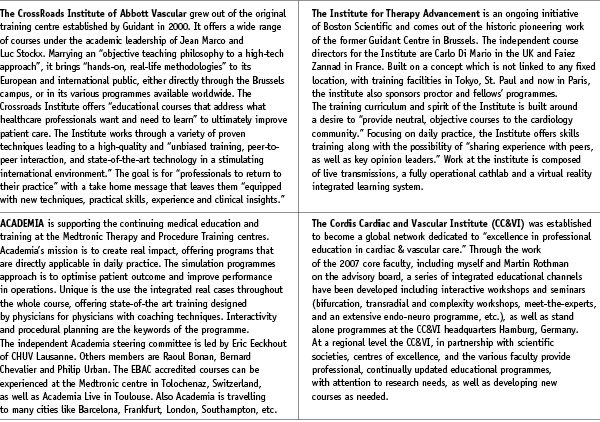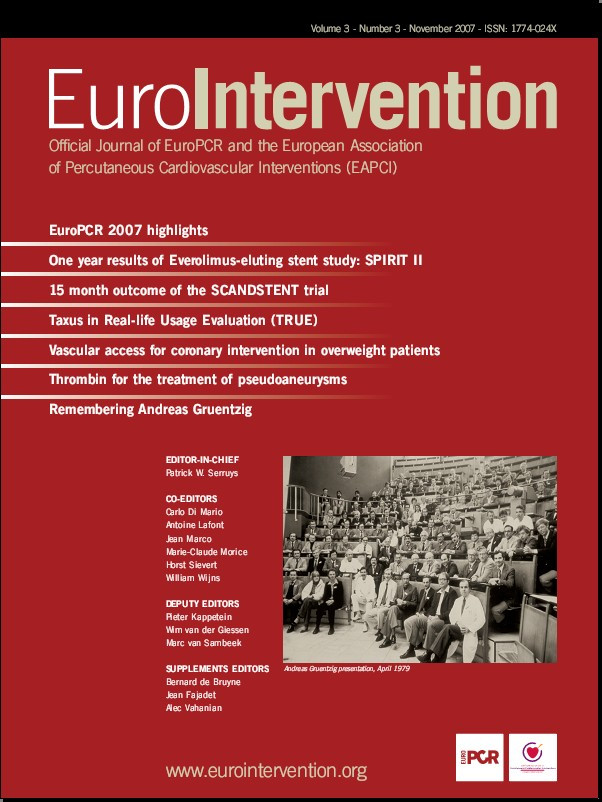Ongoing needs
As we round the corner of our first year of existence, the challenges facing our young association remain vast and complex, with the issues of accreditation and increasing grass roots support and participation paramount.
One of the cornerstones of our work is the listing and classification of all educational and training opportunities now available for interventionalists in Europe. This is not only essential for our members, but allows us to pinpoint weaknesses and identify those areas that still need to be developed. We can all agree that the availability of good training and excellent continuing education is essential in the continuing development of our speciality, and we acknowledge that much exists already. However if these opportunities are not apparent, easily consultable and accessible, then no training programme, no matter how excellent, will be of great use. Throughout Europe, whether you are a recognised expert, mid-career specialist, student or young practitioner, if you do not have a way of knowing what is available, you won’t be able to partake in the experience of your colleagues. In this case the good intentions, educational and training protocols and courses will be of limited value.
Our association, acting as a forum for these educational tools and experience, responds to a real need to fully illustrate what is being offered today. By doing so, it can also highlight what still needs to be done. This overview shows us our blind spots as well. For instance, we can see that there is a whole range of certain essential procedures for junior practitioners that need still to be covered, and here we can suggest that our partners, industry and others, develop useful tools for junior training (for instance in how to perform diagnostic coronary angiograms or right heart catheterisation or pericardial centesis, to name a few).
So while the EAPCI is not a training organisation per se, it can – and is – fast becoming, the umbrella organisation offering the greatest visibility for the myriad of educational and training programmes existing and being developed today. As an immediate vocation, this suits the EAPCI well, and we have begun our work in earnest, documenting the various centres and programmes, whilst beginning to provide, on our website, a centralised location for referencing all of this material, creating a veritable clearing-house of information for our speciality and craft1.
Industry training programmes
At the EAPCI meeting last May during EuroPCR in Barcelona, leaders of our national constituents met and heard presentations by four of our industry partners on their portfolio of educational offerings. Their centres, funded by industry, yet independent of direct control, are each guided by well known senior European specialists, and provide many services, each different, with a wide array of subjects using virtual reality, focus groups, hands-on-training and much more at each of the different sites.
Here is a brief summary of what and who they are (further information can be obtained from our website, or directly thought the different educational institutes).

EBAC certified programmes
In 2005, Heart published an editorial on the “rules of engagement” between industry and science. Entitled “Educational governance for the regulation of industry sponsored continuing medical education in interventional and device based therapies”2 this piece echoed the universal sentiment that “the relationship between industry and clinicians in educational programmes needs to be regulated.” But what does this entail? The authors, Jean Marco, John M. Morgan, Luc Stockx and Faiez Zannad noted that “industry may be best placed to deliver educational programmes in ‘craft’ related specialties and particularly in areas where device implantation/ technology based therapy has a major clinical role.”
For those of us both looking at education and involved in the development of ongoing programmes, the act of regulation, which might appear finite at first, is in fact a process, and like our discipline itself, depends on an open creative process allowing for a certain flexibility in order to fully respond and evolve with the science and practice itself. Ultimately the underlying key for the validity of any of these programmes remains the respected EBAC seal. The European Board for Accreditation in Cardiology (EBAC) accredits international Continuing Medical Education (CME) activities in cardiology in Europe. As a joint project of the European Society of Cardiology (ESC) and the Cardiology Section of the European Union of Medical Specialists (UEMS-CS), the role of EAPCI, an integral part of the ESC insures our part in this process and the legitimacy of our overall endeavour. By working in total transparency with industry, we can approach, give counsel and help manage these training programmes, leading them through EBAC requirements to EBAC accreditation.
The future
Alone, or nationally, none of us have the resources, financial or intellectual, to provide all that is needed in continuing education today, but together, on a European level and partnered with industry, universities, as well as governing bodies we can all move forward.
Those of us who have participated in these educational and training programmes know that they can provide much more than just additional experience or re-validation of our skills. By creating new peer-to-peer relationships and offering us a different dynamic than that of our day-to-day practice, they are unique opportunities to forge the kind of professional community that gives life to our work. In carving the role of EAPCI as an essential part of the continuing educational dialogue for our specialty, our association can become the underlying structure on which that dialogues rests – this is the challenge and work of the EAPCI - our EAPCI – to excel as the ideal forum for our discipline as we continue to meet our goals as healthcare providers.

